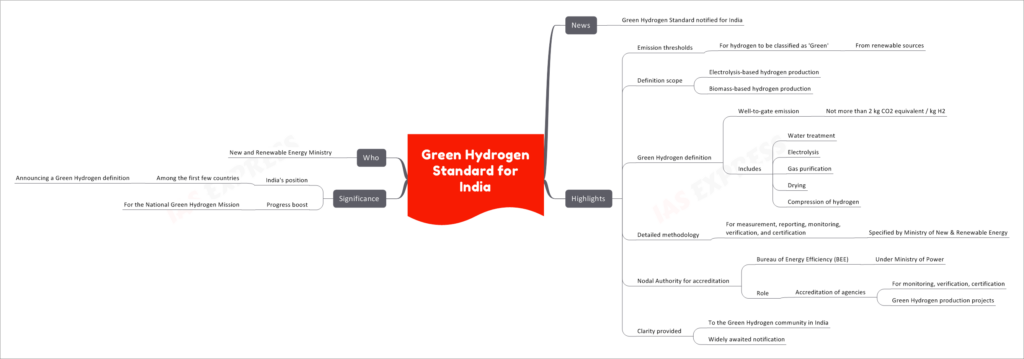Green Hydrogen Standard for India

In a groundbreaking development, India has taken a monumental step towards a sustainable energy future by announcing its Green Hydrogen Standard. This significant move, recently notified by the Ministry of New & Renewable Energy, establishes a comprehensive framework for classifying hydrogen derived from renewable sources as ‘Green.’
This topic of “Green Hydrogen Standard for India” is important from the perspective of the UPSC IAS Examination, which falls under General Studies Portion.
Grasping the Essentials of the Standard
Defining Green through Emission Thresholds
At the heart of the Green Hydrogen Standard lies the establishment of emission thresholds. To be categorized as ‘Green,’ hydrogen must be produced from renewable sources, thereby reducing its carbon footprint.
Scope of the Definition
The standard encompasses two primary methods of hydrogen production:
- Electrolysis-based hydrogen production
- Biomass-based hydrogen production
Cracking the Green Hydrogen Code
The Green Hydrogen definition is quantified through well-to-gate emission measurements, which should not exceed 2 kg CO2 equivalent per kg H2. This comprehensive calculation includes every step of the production process, from water treatment and electrolysis to gas purification, drying, and hydrogen compression.
Methodology for Rigorous Compliance
The Ministry of New & Renewable Energy has outlined a detailed methodology for measuring, reporting, monitoring, verifying, and certifying the greenness of hydrogen production processes. This framework ensures a consistent and standardized approach across the industry.
Nodal Authority for Accreditation
The Bureau of Energy Efficiency (BEE), operating under the Ministry of Power, has been designated as the nodal authority for accrediting agencies involved in monitoring, verification, and certification of Green Hydrogen production projects. This role ensures credibility and integrity in the assessment process.
Clarity and Long-Awaited Notification
The introduction of the Green Hydrogen Standard provides much-needed clarity to the burgeoning Green Hydrogen community in India. The notification was widely anticipated and has now brought a definitive framework to the realm of hydrogen production.
The Far-reaching Significance
India’s Position among Pioneers
India’s declaration of the Green Hydrogen Standard places it among the first few nations to formally define and regulate hydrogen production based on its environmental impact. This pioneering stance underscores India’s commitment to sustainable energy practices.
A Boost to Progress
The standard’s introduction is expected to provide a significant boost to India’s National Green Hydrogen Mission. By establishing a clear and recognized benchmark, the standard accelerates progress towards the mission’s goals, encouraging investment and innovation in the green hydrogen sector.
The Driving Force Behind the Standard
Ministry of New & Renewable Energy
The Ministry of New & Renewable Energy has emerged as the driving force behind the Green Hydrogen Standard. With its visionary approach, the ministry has paved the way for India’s transition to a greener and more sustainable energy landscape.

